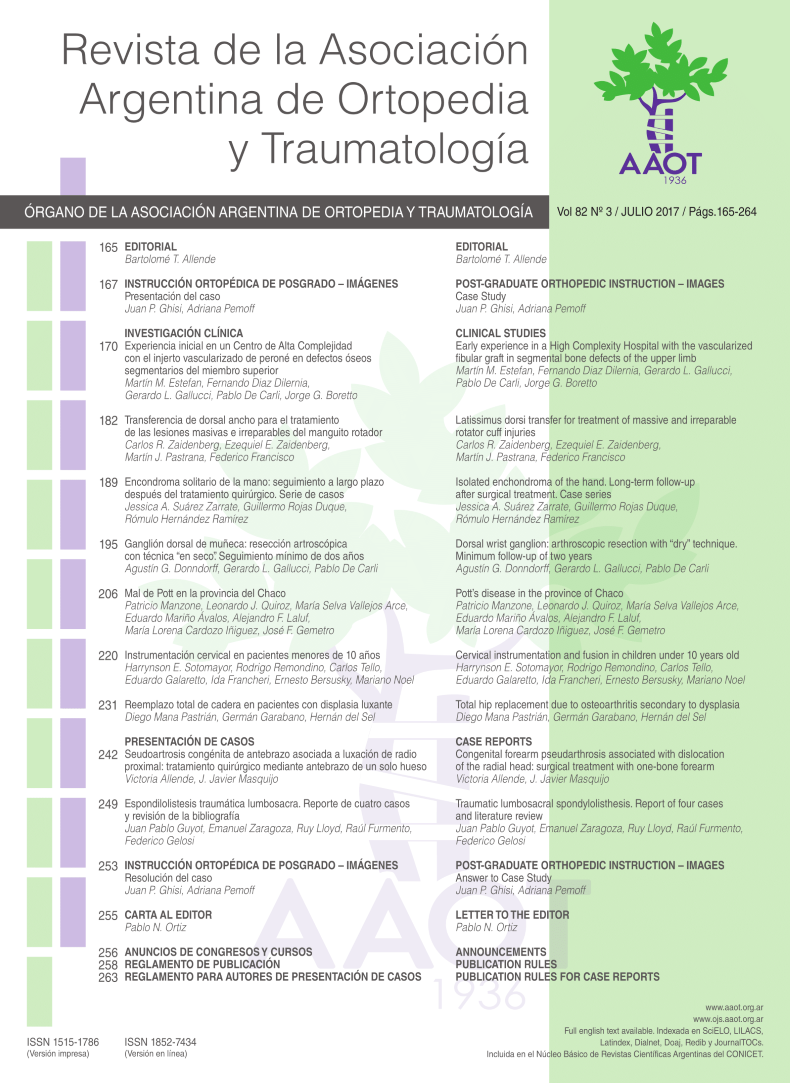Cervical Instrumentation and Fusion in Children Under 10 Years Old
Main Article Content
Abstract
Downloads
Metrics
Article Details

This work is licensed under a Creative Commons Attribution-NonCommercial-ShareAlike 4.0 International License.
Manuscript acceptance by the Journal implies the simultaneous non-submission to any other journal or publishing house. The RAAOT is under the Licencia Creative Commnos Atribución-NoComercial-Compartir Obras Derivadas Igual 4.0 Internacional (CC-BY-NC.SA 4.0) (http://creativecommons.org/licences/by-nc-sa/4.0/deed.es). Articles can be shared, copied, distributed, modified, altered, transformed into a derivative work, executed and publicly communicated, provided a) the authors and the original publication (Journal, Publisher and URL) are mentioned, b) they are not used for commercial purposes, c) the same terms of the license are maintained.
In the event that the manuscript is approved for its next publication, the authors retain the copyright and will assign to the journal the rights of publication, edition, reproduction, distribution, exhibition and communication at a national and international level in the different databases. data, repositories and portals.
It is hereby stated that the mentioned manuscript has not been published and that it is not being printed in any other national or foreign journal.
The authors hereby accept the necessary modifications, suggested by the reviewers, in order to adapt the manuscript to the style and publication rules of this Journal.
References
2. Leonard J, Wright N (2006) Pediatric atlantoaxial fixation with bilateral, crossing C-2 translaminar screws. Technical note. J Neurosurg 104:59–63
3. Jea A, Taylor, Dirks PB, Kulkarni AV, Rutka JT, Drake JM. Incorporation of C-1 lateral mass screws in occipitocervical and atlantoaxial fusions for children 8 years of age or younger. Technical note. J Neurosurg 107:178–183
4. Schmidt, R., Koller H., Wilke H., Brade J., Zenner J., Meier O. M. The Impact of Cervical Pedicle Screws for Primary Stability in Multilevel Posterior Cervical Stabilizations. Spine 2010;35:E1167–E1171
5. Dickman CA, Sonntag VK, Papadopoulos SM, Hadley MN (1991) The interspinous method of posterior atlantoaxial arthrodesis. J Neurosurg 74:190–198.
6. Gallie WE (1937) Skeletal traction in the treatment of fractures and dislocations of the cervical spine. Ann Surg 106:770–776
7. Hedequist D., Hresko T., Proctor M. Modern Cervical Spine Instrumentation in Children Spine.2008;33:379–383
8. Prakash S., William G. M., S. A. Sah., Mihir T., Colleen D., Laurens H., J. Campbell, MD. Occipitocervical Fusion in Skeletal Dysplasia. Spine 2014;39:E912–E918.
9. Michael C. Ain, MD, Kaisorn L. Chaichana, BS, and Joshua G. Schkrohowsky, BS. Retrospective Study of Cervical Arthrodesis in Patients With Various Types of Skeletal Dysplasia. Spine 2006;31:E169–E174
10. Ryoji Tauchi • Shiro Imagama • Zenya Ito • Kei Ando • Kenichi Hirano • Akio Muramoto. Complications and outcomes of posterior fusion in children with atlantoaxial instability. Eur Spine J (2012) 21:1346–1352
11. Doyle, J. Scott MD; Lauerman, William C. MD; Wood, Kirkham B. MD; Krause, David R. Complications and Long-Term Outcome of Upper Cervical Spine Arthrodesis in Patients With Down Syndrome. Spine Volume 21(10), 15 May 1996, p 1223–1231
12. Rishimugesh Kanna P, Ajoy Prasad Shetty, Rajasekaran S. Anatomical Feasibility of Pediatric Cervical Pedicle Screw Insertion by Computed Tomographic Morphometric Evaluation of 376 Pediatric Cervical Pedicles. Spine 2011 ; 36 : 1297 – 1304
13. Ferri-de-Barros F., Little D. G., Bridge C., Cummine J, Cree K. A. Atlantoaxial and Craniocervical Arthrodesis in Children. A Tomographic Study Comparing Suitability of C2 Pedicles and C2 Laminae for Screw Fixation. Spine 2010;35:291–293
14. Abdullah K.G., Steinmetz M. P., Mroz T. E. Morphometric and Volumetric Analysis of the Lateral Masses of the Lower Cervical Spine. Spine 2009;34:1476–1479
15. Jeanneret B, Magerl F (1992) Primary posterior fusion C1/2 in odontoid fractures: indications, technique, and results of transarticular screw fixation. J Spinal Disord 5:464–475
16. Roy-Camille R., Saillant G., Laville C. Treatment of lower cervical spinal injuries—C3 to C7. Spine 1992. 17(10 Suppl):S442–S446
17. Heller JG, Carlson GD, Abitbol JJ. Anatomic comparison of the Roy-Camille and Magerl techniques for screw placement in the lower cervical spine. Spine 1991. 16(10 Suppl):S552–S557
18. Grob D, Crisco JJ III, Panjabi MM, et al. Biomechanical evaluation of four different posterior atlantoaxial fixation techniques. Spine 1992;17:480–90.
19. Brockmeyer DL, York JE, Apfelbaum RI (2000) Anatomical suitability of C1–2 transarticular screw placement in pediatric patients. J Neurosurg 92:7–11
20. Heuer GG, Hardesty DA, Bhowmick DA, Bailey R, Magge SN, Storm PB (2009) Treatment of pediatric atlantoaxial instabilitywith traditional and modified Goel-Harms fusion constructs. Eur. Spine J. 2009, 18:884–892

